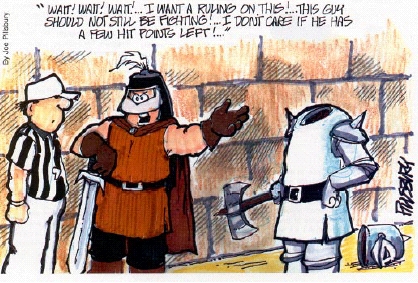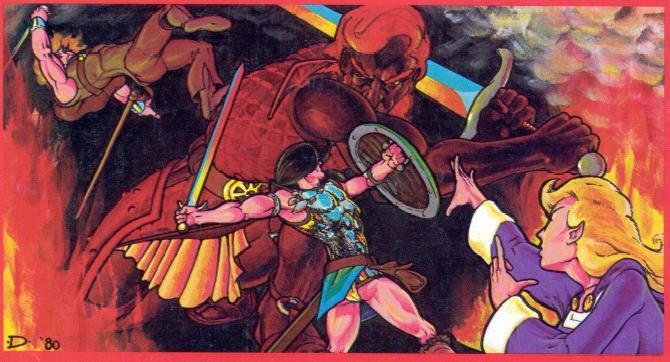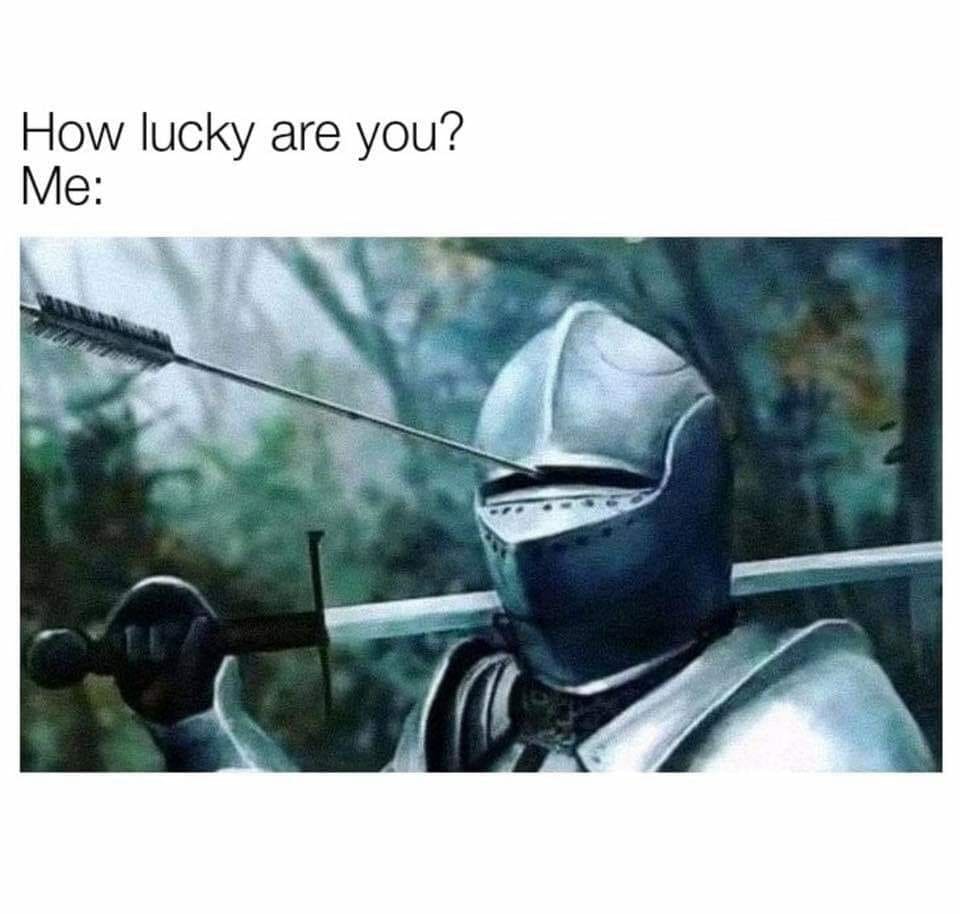

Hit: R-M = C
Miss: M-R = F
R = number rolled on the d20
M = minimum roll needed to hit
C = chance for a Crit, expressed as a %
| Edged Weapons | Blunt Weapons | Missile & Thrusting Weapons | Vs. Animals | Fumbles (Alt) |
| Dragon 39 | - | Best of Dragon, Vol. V | - | Dragon |
Critical Hits Effects Table -- Edged Weapons
| d% | Result |
| 01-31 | Double damage |
| 32-62 | Triple damage |
| 63 | Shield destroyed (no effect if no shield) |
| 64 | Shield destroyed (roll again if no shield) |
| 65 | Helm removed (lose ear; stunned 1-6 rounds if no helm) |
| 66 | Helm removed (lose ear, stunned 1-6 rounds) |
| 67 | Voice box punctured, no talking (no effect if helmed) |
| 68-69 | Ear removed (no effect if helmed) |
| 70 | Ear removed (helm removed if helmed) |
| 71-72 | Eye removed (no effect if helmed) |
| 73 | Eye removed |
| 74 | Knee split; movement halved |
| 75 | Knee split; no movement |
| 76 | Fingers removed; DEX reduced 1-3 points |
| 77 | Leg removed at ankle |
| 78 | Leg removed at knee |
| 79 | Leg removed at hip |
| 80 | Shield arm removed at wrist (no effect if shield) |
| 81 | Shield arm removed at elbow (no effect if shield) |
| 82 | Shield arm removed at elbow (no effect if shield) |
| 83 | Shield arm removed at wrist |
| 84 | Shield arm removed at elbow |
| 85 | Shield arm removed at shoulder |
| 86 | Weapon arm removed at wrist |
| 87 | Weapon arm removed at elbow |
| 88 | Weapon arm removed at shoulder |
| 89 | Abdominal injuries; carry capacity halved |
| 90 | Chest injuries; carry capacity halved |
| 91 | Abdominal injuries; death in 1-6 days |
| 92 | Chest injuries; death in 1-4 days |
| 93 | Abdominal injuries; death in 2-12 turns |
| 94 | Chest injuries; death in 2-8 turns |
| 95 | Abdominal injuries; immed. death |
| 96 | Chest injuries; immed. death |
| 97 | Throat cut; immed. death (no effect if helmed) |
| 98 | Throat cut; immed. death |
| 99 | Decapitated; immed. death (no effect if helmed) |
| 00 | Decapitated; immed. death |

Critical Hit Effects Table—Blunt Weapons
| d% | Result |
| 01-31 | double damage |
| 32-64 | triple damage |
| 65-66 | shield broken (no effect if no shield) |
| 67-68 | shield broken (roll again if no shield) |
| 69-70 | shield arm struck (no shield defense for 1-6 rounds) |
| 71-72 | shield arm broken; lose shield |
| 73-74 | weapon arm struck; hit probability -2 |
| 75-76 | weapon arm struck; hit probability -4 |
| 77-78 | weapon arm broken; no attacks |
| 79-80 | hand struck; dexterity down 1-5 points until healed |
| 81-82 | hand struck; dexterity down 1-5 points |
| 83-84 | chest struck; stunned 1-6 rounds |
| 85-86 | chest struck; ribs broken, lungs punctured; no movement |
| 87-88 | chest struck; ribs broken, heart punctured; death. |
| 89-90 | leg struck; fall to ground |
| 91-92 | leg struck; movement halved |
| 93-94 | leg broken; no movement |
| 95 | head struck; lose 1-6 pts INT (no effect if helmed) |
| 96 | head struck; lose 1-6 pts intelligence |
| 97 | head struck; lose 2-12 pts intelligence (no effect if helmed) |
| 98 | head struck; lose 2-12 pts intelligence |
| 99 | skull crushed; dead (no effect if helmed) |
| 00 | skull crushed; dead. |
Critical Hit Effects Table—Missile and Thrusting Weapons
| d% | Result |
| 01-34 | double damage |
| 35-70 | triple damage |
| 71-72 | shield arm struck (no effect if shield) |
| 73-74 | shield arm struck |
| 75-76 | weapon arm struck; hit probability -2 |
| 77-78 | weapon arm struck; hit probability -4 |
| 79-80 | weapon arm struck; no attacks |
| 81-82 | struck in abdomen; death in 1-6 days |
| 83-84 | struck in chest; death in 1-4 days |
| 85-86 | struck in abdomen; death in 2-12 turns |
| 87-88 | struck in chest; death in 2-8 turns |
| 89-90 | struck in abdomen; immediate death |
| 91-92 | struck in chest; immediate death |
| 93 | blinded in eye (no effect if helmed) |
| 94 | blinded in eye |
| 95 | larynx punctured (no effect if helmed) |
| 96 | larynx punctured |
| 97 | struck in head; lose 1-6 pts INT (no effect if helmed) |
| 98 | struck in head; lose 1-6 pts INT |
| 99 | struck in head; immediate death (no effect if helmed) |
| 00 | struck in head; immediate death |
-
Critical Hit Effects vs. Animals
| d% | Result |
| 01-29 | double damage |
| 30-58 | triple damage |
| 59-60 | limb removed at body; speed halved |
| 61-62 | limb removed at midpoint; speed halved |
| 63-64 | limb removed at midpoint; hit probability -2 |
| 65-66 | limb removed at body; hit probability -4 |
| 67-68 | limb removed at midpoint; speed halved, hit prob. -2 |
| 69-70 | limb removed at body; speed halved, hit probability -4 |
| 71-72 | throat cut: immediate death |
| 73-74 | decapitated |
| 75-76 | abdominal injuries; immediate death |
| 77-78 | abdominal injuries; death in 2-12 turns |
| 79-80 | abdominal injuries; death in 1-6 days |
| 81-82 | chest injuries; immediate death |
| 83-84 | chest injuries; death in 2-8 turns |
| 85-86 | chest injuries; death in 1-4 days |
| 87-90 | snout struck; immediate retreat |
| 91-94 | snout struck; hit probability -2 for 1-4 rounds |
| 95-98 | snout struck; hit probability -4 for 1-4 rounds |
| 99 | head struck; stunned for 1-6 rounds |
| 00 | head struck: immediate death |
Fumble Effects Chart-All Weapons <(Alt)>
| 01-19 | slip; roll dexterity or less on d20 or fall and stunned for 1-4 rounds |
| 20-33 | stumble; roll dexterity or less on d20 or fall and stunned for 1-6 rounds |
| 34-39 | trip and fall; stunned for 1-6 rounds |
| 40-44 | off balance; roll dexterity or less on d20 or no action next round |
| 45-49 | lose grip on weapon; roll dexterity or less on d20 or no attack next round |
| 50-54 | lose grip; roll dexterity or less on d20 or drop weapon |
| 55-59 | lose grip; drop weapon |
| 60-61 | shield tangled with opponent (no effect if no shield) |
| 62-63 | shield tangled with opponent; neither attacks next round |
| 64-65 | weapon tangled with opponent; no attack next round |
| 66-69 | weapon knocked away-roll d8 for direction, d10 for distance in feet |
| 70-74 | weapon breaks (base 100% chance -20% for each “+” or ability of weapon |
| 75-76 | hit self; half damage |
| 77-78 | hit self; normal damage |
| 79-80 | hit self; double damage |
| 81-82 | hit friend; half damage |
| 83-84 | hit friend; normal damage |
| 85-86 | hit friend; double damage |
| 87-88 | critical hit, self |
| 89-90 | critical hit, friend |
| 91-92 | twist ankle; half speed for 1 turn, roll dexterity or less on d20 or fall |
| 93-95 | helm slips; roll dexterity or less to fix, hit probability -6 until fixed |
| 96-97 | helm slips; roll dexterity to fix, no attacks until fixed |
| 98 | distracted; opponent’s next attack at +3 |
| 99 | roll twice, ignoring rolls of 99 or 00 |
| 00 | roll three times, ignoring rolls of 99 or 00 |
GOOD HITS & BAD MISSES
Carl Parlagreco
Critical hits and fumbles are probably two
of the most controversial
subject areas in D&D.
The most common procedure is for 20 to <The version in Best of Dragon
V mentions 'D&D and AD&D' here.>
represent a “perfect hit” and 1 a “perfect
miss,” or a critical hit and a
fumble, respectively. This is an overly
simplistic system, and this
seems to be the main problem. The problem
is less severe with
20’s—a character’s strength and dexterity
bonuses, along with any
magical help coming from swords and the
like, often combine to
modify the die roll to or above the magic
score of 20.
Stronger characters have a relatively better
chance at reaching
this score, so do higher-level characters
(but only because higherlevel
characters will presumably have more powerful
magic swords).
Unfortunately, the problem is that a character
who can only hit
his/her opponent on a roll of a 20 will
get critical hits as often as one
who needs only a 10 or better.
When applied to fumbles, the simple system
really falls apart. A
roll of 1 is a fumble-period. An 18/00
STR, an 18 DEX, a
+5 sword, none of it will help. Or, if
these will help, then what’s the
point of having the rule, since all one
needs is a + 1 dagger to boost
any rolls of 1 up to 2, and your worries
are over. And, if a 1 is always a
fumble, a character will fumble 5% of the
time, whether he or she is
1st, 5th, or 15th level.
The following variant system allows swords
and dexterity to
increase chances for a critical hit, and
reduce chances for a fumble,
without eliminating them entirely. Basically,
any swing that hits can
be a critical hit, and any swing that misses
can be a fumble. The
higher the die roll, the “better” the swing,
and the more likely it will
be critical. The system works as follows:
The character rolls the die normally, to
determine if he/she has
hit. If the roll is a hit, then the minimum
score necessary to hit is
subtracted from the roll, and the result
is the percentage chance of
the hit being a critical hit. If the swing
is a miss, the result is subtracted
from the minimum score needed to hit, and
that is the chance of the
swing being a fumble.
EXAMPLE: Ferdinand Orc-Punter, +2
hit probability due to
strength, +2 sword, needs a 10 or better
to hit Sorghum Orc. He
swings, rolling a 14, +2 (for strength)
+2 (for the sword), with the
final result of 18. A hit! The chance of
it being critical is 18 (the final
result) minus 10 (the minimum score needed),
which is 8 (the
percentage chance of the hit being critical).
EXAMPLE: Sampson Numbfingers has
+ 1 hit probability and a
+1 dagger. He needs an 11 or better to
hit a bugbear. He rolls
4+ 1 + 1=6. A miss. The chance he will
fumble is 11-6. which is 5.
This system is nicely symmetrical, and
works well. If the percentages
seem too high, they can always be halved.
The tables below are for the various kinds
of critical hits. The first
table is primarily for swords, but is also
used for poleaxes, oxtongues,
and the other large cutting weapons that
pop up occasionally.
The second table is for maces, with other
fun things such as
falling rocks being rolled for here, if
desired. The table for critical hits
against animals is used for all weapons.
The missile fire critical hits
table is also for thrusting weapons such
as spears, and for daggers.
The fumble table is also for all weapons.
Most of the results are
minor, such as losing one’s balance or
dropping a weapon, but even
the nastier ones, such as “hit self,” aren’t
unreasonable to allow for.
If you’ve ever seen an SCA (Society for
Creative Anachronism)
tournament, you can probably understand
how it can happen.
In using the charts, some referee input
is necessary. When fighting
an elephant
with a dagger, it’s not too likely that one of the
elephant’s legs will be lopped off by a
critical hit.
Also,
a character who is missing an arm or two won’t be in very
good condition, and
is likely to bleed to death. Still, there are
instances where the
character insists on fighting to the end. In these
cases, have the character
roll a system shock check. If the check is
made, then he/she
can continue on fighting (provided he/she has
the limbs necessary),
although 1-3 pts. of damage are taken each
round until something
is done to bandage up the wound. If the
system shock check
is failed, the character falls unconscious due to
pain for 1-12 rounds.
Q. Where does the 'double
damage for a
20' rool come from?
A. This rool is generally
taken to mean
that when the 'to hit' die
is rolled and
a natural 20 comes up, any
subsequent
damage done by the attack
is
a 'critical hit', and does
twice as
much damage. The rool
is widely
used, especially when characters
attack monsters (monsters
rarely get
this rule used in their favor).
If they
did, fewer players would
be as keen
on the idea--a fire
giant who rolled a
20 would do as much as 60
points of
damage with one blow!
The idea
of 'critical hits' has never
been an Official part of
The Game. It is
most likely that it has been
borrowed
and much-simplified from
game
systems where this rool exists.
(Imagine #13)
Rothe wrote:
Gary,
I still remember vivdly when
I first cracked Men & Magic in 1976 and I'm deeply impressed that after
all these years you take time to diligently respond to questions.
So are critical hits still
not part of AD&D![]()

Howdy,
Not in a game i run...though
if the players really insist I can deal with it as I tend to roll a lot
of 18, 19, and 20 results for the NPCs/monsters.
so if they want their PCs
dead quickly, I can oblidge;)
Cheers,
Gary

Here we go again . . . more of the critical hits
business. Worse still, misses which hit the supposedly
professional fighter or whack a friend.
Stupid, really stupid. For those who use critical
hits, here are some for monsters:
Any 20 indicates a critical hit on the character.
Attack form:
ACID/DISSOLVING: Character’s legs destroyed—
totally helpless
BITE: Character’s jugular vein severed—
instant death
BLOW (as from a giant): Character’s skull
smashed—instant death
CLAW: Character’s eyes tom out—defenseless
CLAW: Character’s eyes tom out—defenseless
CONSTRICTION: All bones broken—permanently
destroyed
CUT: Character’s head cut off—instant
death
HORN: Character’s heart pierced—instant
death
HUG: Character’s spine snapped—instant
death
MISSILE: Lungs pierced—instant death
POISON: Quintuple dose; destroys arteries
or nervous system—permanently destroyed
Use your <IMAGINATION> for other attacks.
(Note that this is not “official,” but it is more
“official” than critical hits and misses.)
As a final word: No more Mr. Niceguy!
E. Gary Gygax
Lake Geneva, Wis
(Dragon #41)
[edit]
"My soul for #39"
Dear Editor:
Although I am not a regular subscriber to
The Dragon, (alas, the ole cash just isn’t
there
when you need it) I managed to trade my soul
away for a copy of #39. I have just finished reading
it and feel that there are a few things I must
comment on. The first thing is the article “Good
Hits and Bad Misses” by Carl Parlagreco. It is an
excellent system and I found it to be quite playable
when combined with a little common sense. Previously,
I had used the system in the Arduin
trilogy, but Mr. Parlagreco’s system has worked
much better for me.
Russell Shiffer
Walnut Creek, Calif.
(Dragon #43)